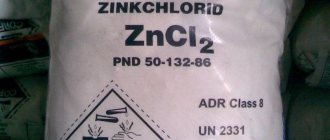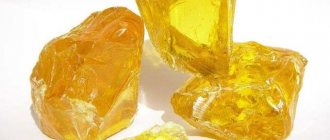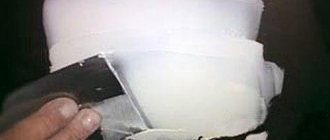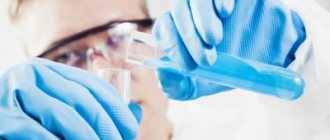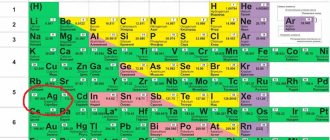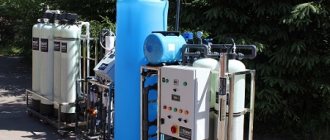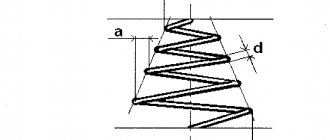Hydrochloric acid is used in the manufacture of some explosives. Now it is a recursor, and you won’t be able to purchase it in Himmag. But it is quite easy to make at home. Chemically pure concentrated hydrochloric acid is a colorless liquid that fumes in air (hydrogen chloride is released) with a pungent odor. The density of hydrochloric acid is 1.19, at a concentration of 37%.
Reagents:
NaCl – table salt. In principle, any chloride will do, KCl for example.
H2SO4 – sulfuric acid. It must be concentrated (chars the match when cold), evaporated electrolyte is quite suitable.
Protective equipment:
Hydrochloric acid is EVIL! Causes chemical burns upon contact with skin. It shouldn't get on your clothes either - it corrodes instantly. Hydrogen chloride is poisonous! It is better to produce hydrochloric acid outdoors or in a well-ventilated area. Minimum protective equipment: 1. Rubber gloves (preferably as in the photo). 2. A gas mask or respirator (will help you quickly eliminate the consequences of a possible accident without harm to health).
Equipment: 1. Electric stove or other heat source. 2. Libra. 3. Measuring cup. 4. Reaction vessel, I used a 250 ml flat bottom flask. 5. Safety bottle. Any flask will work perfectly (the main thing is that the volume of the flask is not less than the volume of the acid produced). 6. A pair of rubber plugs. 7. Tubes, you can use tubes from IVs.
The result should be a device like this.
True, there are a couple of nuances here: 1. The tubes used in the device must be of the same diameter; it is better to avoid using syringe needles as fittings. This will create a pressure difference and the device will explode (this happened to me when using a syringe needle). 2. It is better not to immerse the tube from which HCl comes into water, since water can be sucked into the system due to the high solubility of HCl. 3. The safety flask is, in principle, optional, you can do without it, but if water is sucked into the reaction flask and it may burst, spraying hot sulfuric acid.
Manufacturing:
1. Weigh out about 10-20 grams of salt. Take about the same amount of acid, 10-15 milliliters. I wrote approximately because the amount of acid depends on its concentration. I took 1:1 by volume. If the acid is 60-80%, then hydrogen chloride will first dissolve in water, and only then will it be released.
In short, LESS WATER – LESS PROBLEMS! So it is better to spend more time evaporating the electrolyte.
2. Place the salt in the reaction flask. 3. We assemble the installation, check all connections, they must be tight. 4. Pour 50-100 ml into a measuring cup. water (preferably distilled) and insert a tube into it. 5. We put on a gas mask. 6. Now the main thing is to quickly pour sulfuric acid into the reaction flask and plug the neck with a gas outlet tube. A gas mask will save you from the hydrogen chloride that will begin to be released. 7. At first the reaction occurs on its own, then the flask needs to be heated a little. NaCl + H2SO4 → Na2SO4 + 2HCl↑
The following are photographs of the device and the entire process:
In this way you can obtain acid with a maximum concentration of 37-40%. During the receiving process, you will see how the volume of water that you poured into the glass begins to increase. Continue saturating the water until the gas no longer dissolves. The acid should be stored in a tightly closed container to avoid volatilization of HCl. GOOD LUCK!
Currently, the choice of rechargeable batteries is huge - on sale you can find ready-to-use power sources, as well as dry-charged batteries that require preparing the electrolyte and filling it before use. Many people often carry out further battery maintenance at service centers. For various reasons, it may be necessary to prepare the solution yourself. For this event to be successful, you should know how to make electrolyte at home.
Making acid at home
Let's try to make alkali or acid at home using improvised means.
Of course, the preparation we receive will not be concentrated (this is achieved using special equipment), but the characteristic properties of the acid will certainly be noticeable. The easiest way to obtain acid at home
will be based on the electrolysis of some solution, which dissociates to form a sulfate ion. It is also possible to obtain acid in another way, but this involves either obtaining sulfur dioxide or other chemicals that may not be available, and all of them are dangerous enough to work with at home. Therefore, we obtain, for example, sulfuric acid (diluted) from copper sulfate. The concentration obtained from vitriol is not particularly dangerous, and besides, little money is needed to obtain it. So, for the experiment we need a current source (a power supply from 15 to 30 volts is perfect). We will take a graphite anode (electrode connected to the positive) so that it does not dissolve. Cathode - it is better to take the form of a graphite plate, but you can also use copper foil.
Dilute the vitriol solution and lower the electrodes into it. At the cathode we will observe the release of a brown, loose substance - this is copper.
What is copper sulfate? This is copper dissolved in sulfuric acid. Get ready to periodically remove the cathode "-" and clean it of the copper deposited on it. The longer the experiment continues, the lighter the solution of our electrolyte becomes - copper is removed from it. If we lower our indicator into a lightened solution, the color will change to scarlet. After all, sulfuric acid! Of course, it is highly diluted, but still exhibits its properties. In order to be more sure of the resulting acid, take baking soda and drop the resulting acid onto it - in this case, a rapid release of gas should be observed - this is carbon dioxide. Sulfuric acid reacts with baking soda to form sodium salt (Na2SO4), water and carbon dioxide bubbles.
It worked! For some substances it is rather weak (because it is very diluted) and you will not observe reactions with them.
Of course, you can increase the concentration of the acid by dissolving more copper sulfate in water or by evaporating the excess water in the resulting acid. I don’t recommend doing the latter, because... acid fumes are very dangerous.
- HCl - pH=1.0
- CCl3COOH - pH=1.2
- H2C2O2 - pH=1.3
- NaHSO4 - pH=1.4
- Tartaric acid – pH=2.0
- Citric acid – pH=2.1
- Lactic acid - pH=2.4
- Salicylic acid – pH=2.4
- Succinic acid – pH=2.7
- C6H5COOH – pH=2.8
- CH3COOH - pH=2.9
- NH4H2PO4 - pH=4.0
- H2S - pH=4.1
- NaH2PO4 - pH=4.5
- KH2PO4 - pH=4.7
- HCN - pH=5.1
- NH4Cl - pH=5.1
- H3BO3 - pH=5.3
- (NH4)2SO4 – pH=5.5
- Phenol - pH=5.5
- CaCO3 - pH=7.3
- (NH4)2HPO4 - pH=7.9
- C6H5COONa – pH=8.0
- NaHCO3 - pH=8.3
- CH3COONa – pH=8.9
- Na2HPO4 - pH=9.2
- Mg(OH)2 — pH=10.0
- KCN - pH=11.1
- NH3 - pH=11.3
- Na2CO3 - pH=11.6
- Na3PO4 - pH=12.0
- Ca(OH)2 - pH=12.4
- Na2SiO3 - pH=12.6
- K2S - pH=12.8
- NaOH - pH=13.0
Which acid is more acidic?!
You have probably ever asked the question “which acid is more acidic?!” “or which of the alkalis is more caustic?!” This question can be answered by considering the pH values of solutions of acids and alkalis. There are a lot of acids, so we will consider only the most basic ones. The pH value of the solution depends on the concentration. Therefore, the table shows the pH values of aqueous solutions at a concentration of 0.1 mol/l. For poorly soluble compounds marked with an asterisk, the pH of saturated solutions is indicated. The lower the pH value of the solution, the more acidic the acid, and vice versa, the higher the pH value of the solution, the more caustic the alkali! It turns out that if you drink concentrated lemon juice, the acidity of gastric juice... will decrease!? Indeed, a solution of citric acid will only dilute the stronger hydrochloric acid contained in gastric juice.
ความคิดเห็น • 0
the acid is not diluted but the solution is saturated because there is sulfur in it, which has not gone anywhere and the electrolyte remains since silver reacted with sulfur. I'm
wildly sorry, but do not mislead people, hodgepodge with copper does not react thclips.com/video/cA25vyFcL6A/วีดีโอ .html, and copper apparently dissolves, due to the fact that the sulfuric acid from the electrolyte does not completely react with the salt and something remains
Copper does not dissolve in sulfuric acid and a mixture of hydrochloric and sulfuric acid also does not dissolve copper.
It is not possible to filter metals in a liquid; you can precipitate them and then filter them
“there was a reaction in the process” um where is the reaction in the video? somehow she wasn’t anywhere.
the reaction lasts several days and proceeds slowly.
“behind the scenes” and why behind the scenes? Why not show me how you do it? You seem to be twisting something.
What electrolyte concentration?
Electrolyte density is 1.27.
Question. Will the concentration increase if you evaporate?
@Detalius Thanks. Understood.
No, there is no need to evaporate, the chlorine evaporates.
Have you tried evaporating the electrolyte x3 times for a more concentrated H2SO4?
If there is no water, then the hodgepodge will have nothing to dissolve in; it simply won’t work.
For aqua regia suitable for dissolving gold
You have been issued a transcript of “Khimik”
Please tell me. Can I use electrolyte from an old battery?
Do you have to wait a week? Isn’t it possible to just shake it so that the salt dissolves and use it right away?
Hello, will it dissolve lead?
What percentage did it turn out to be? 30%, 40%, 50%. Thank you in advance.
Can I ask a professional? I made acid using this method, but the electrolyte evaporated a little (it turned out to be about 55%). I defended it for almost a week. Yesterday I decided to filter. It didn’t work through a cotton pad, because it liquefied and fell into the watering can. Strained through a cloth. I put it in the barn and went to work at night. In the morning it came - and at the bottom there was a sediment in the form of transparent crystals like a herringbone or a hedgehog, in short, thorns. What it is? There was frost at night. I would have assumed that these were salts of sulfuric acid, if not for the fact that I had previously frozen hodgepodge (albeit from salt and a regular electrolyte of 1.27) in the freezer, and the sediment was completely different.
I didn't do that, I can't say. Try leaving it at room temperature. The crystals should melt, most likely it is the salt that has come out.
Amount of starting substances
To prepare an electrolyte with a given density value, you need to take a strictly defined amount of starting substances. The table below shows the most common density values for different types of electrolyte.
| Density, g/cm3 | Amount of water, l | Amount of acid, l | Amount of alkali, kg | Electrolyte freezing temperature, °C |
| 1,24 | 0,819 | 0,242 | -45 | |
| 1.25 | 0,809 | 0,253 | -50 | |
| 1.26 | 0,8 | 0,263 | -55 | |
| 1.27 | 0,791 | 0,274 | -60 | |
| 1.28 | 0,781 | 0,285 | -65 | |
| 1,15 – 1.21 | 3 | 1 | -19 … +35 | |
| 1.25 – 1.27 | 2 | 1 | -20 … -40 |
To increase the permissible operating temperature in regions with hot climates or in enterprises with high ambient temperatures, caustic lithium is added to alkaline batteries in an amount of 15-20 g. per liter of electrolyte.
What is formed during the interaction
The acidic residue is no longer as dangerous as the original component. It is interesting that it is the reaction with the release of carbon dioxide that soda is responsible for adding it to bread - the carbon dioxide released due to interaction with lactic acid raises the dough and makes bubbles in it.
The neutralization reaction occurs in approximately the same way: the base reacts with H2SO4 and carbon dioxide is released. Therefore, to prevent this chemical experiment from turning into a disastrous life experience, it should be carried out in a ventilated area.
On the question of how much soda is needed to neutralize H2SO4. If you take 1 part acid, 1 part alkali will be useful to react with it, that is, the ratio will be 1:1. But concentrated acid requires more soda, here the ratio will increase to 1:2. Soda solution required 3%.
In addition, if it is necessary to provide assistance for an acid burn, then prepare a solution of soda in a very approximate amount: 1 teaspoon of alkali and 2.5 glasses of water. How effective is the reaction? Feedback from those who often encounter it will help you figure this out.
Recommended for you:
How to apply and use soda ash at home
Water acidity
Most living organisms can only exist in environments close to neutral. This is due to the fact that under the influence of H + and OH - ions, many proteins containing acidic or basic groups change their configuration and charge. And in strongly acidic and strongly alkaline environments, the peptide bond breaks, which connects individual amino acid residues into long protein chains. Because of this, ultrabasic (highly alkaline) solutions cause alkaline burns to the skin and destroy silk and wool, which are made up of protein. All living organisms are forced to maintain a certain acidity value in intracellular fluids (and since the cell consists of 80% water, then the acidity of the water
). Natural water is capable of maintaining a pH value more or less constant, even if a certain amount of acid or base enters it from the outside. If a drop of concentrated hydrochloric acid is added to a liter of distilled water, the pH will drop from 7 to 4. And if a drop of hydrochloric acid is added to a liter of river water with pH = 7, the pH will hardly change. Acids and bases entering natural water are neutralized by carbon dioxide and bicarbonate ions dissolved in it: H + +HCO -3 → H2O + CO2; OH - +CO2→HCO -3.
Disposing of acid at home
Some acid solutions are also used in everyday life. For example, “solyanka” is used to get rid of limescale. It is also used to remove rust stains from clothing.
Popular articles Congratulations to veterans on Victory Day 2021
Acetic acid is part of the well-known vinegar and vinegar essence.
How to dispose of expired acetic acid? To dispose of it at home, you must:
Take a plastic container with a volume twice the volume of the solution to be disposed of. To prevent the container from melting or catching fire, transfer the empty container to a bucket of ice. Pour water into an empty container Carefully pour the acid solution into the water, paying attention to the temperature of the container
Important! You cannot pour water into concentrated acid, otherwise the water may instantly boil and the acid may splash.
Using indicator paper (purchased at a specialty store), determine the pH of the solution to be disposed of. The lower the pH, the greater the amount of solution required for the neutralization reaction will be needed.
Make the solution necessary for neutralization. The substances most commonly used for this purpose (for example, magnesium hydroxide) can be purchased in stores. Carry out a neutralization reaction
The solutions prepared at the previous stage react with disposed acids, ultimately forming salts and water. The process can be considered complete if the indicator paper corresponds to a pH level of 6 - 7. Pour the resulting safe mixture down the drain (it is advisable to keep the water tap open).
Hydrochloric acid
#1 Tim_
- Users
- 146 messages
We continue the series of articles on household chemicals
